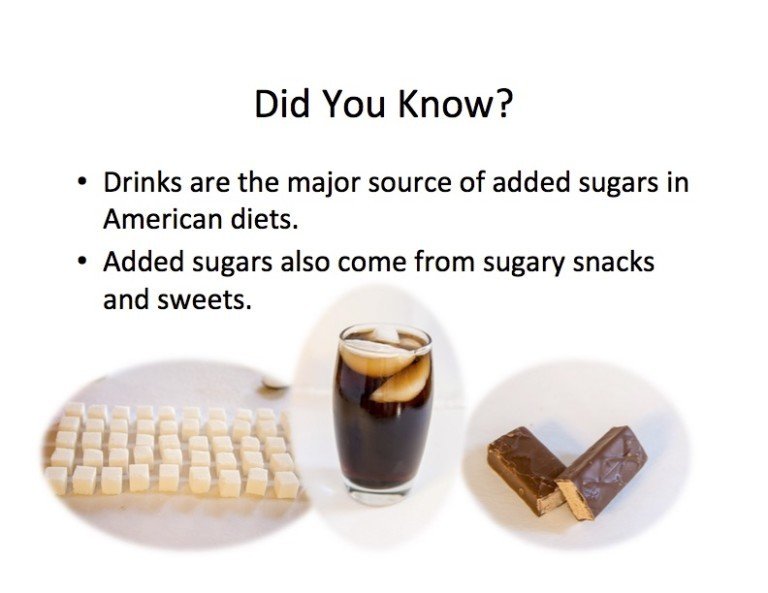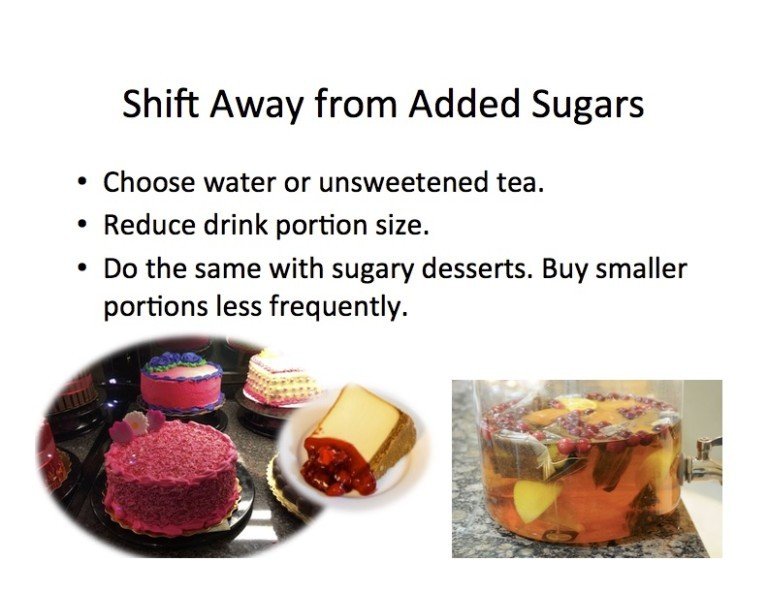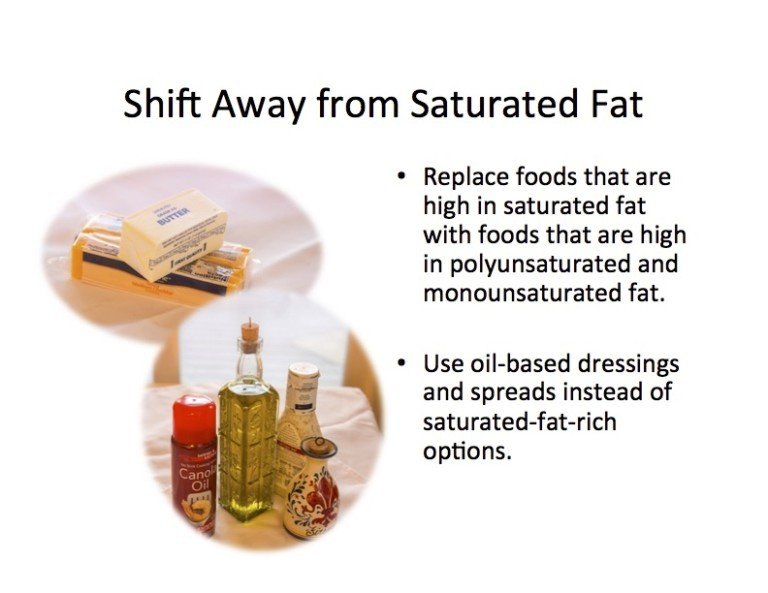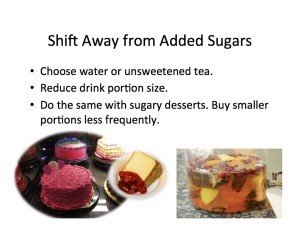Shift Away from Added Sugars and Saturated Fats
Practical Tips for Dietary Shifts got our conversation started with a few samples of foods to shift towards, but in order to craft a balanced and healthy eating pattern, there are also some food elements to shift away from. Today I want to zoom in on two of those elements: added sugars and saturated fats. To do so, I am going to offer a preview of 3 more slides from the Dietary Guidelines for Americans PowerPoint presentation (available now in the Nutrition Education Store)! Did you know that the major source of added sugars in typical American diets is drinks? Think soft drinks, sweetened coffee and tea, alcoholic beverages, fruit drinks, energy drinks, flavored waters, etc. The Dietary Guidelines for Americans explain, “Beverages account for almost half (47%) of all added sugars consumed by the U.S. population. The other major source of added sugars is snacks and sweets, which includes grain-based desserts such as cakes, pies, cookies, brownies, doughnuts, sweet rolls, and pastries; dairy desserts such as ice cream, other frozen desserts, and puddings; candies; sugars; jams; syrups; and sweet toppings. Together, these food categories make up more than 75 percent of intake of all added sugars.”
Did you know that the major source of added sugars in typical American diets is drinks? Think soft drinks, sweetened coffee and tea, alcoholic beverages, fruit drinks, energy drinks, flavored waters, etc. The Dietary Guidelines for Americans explain, “Beverages account for almost half (47%) of all added sugars consumed by the U.S. population. The other major source of added sugars is snacks and sweets, which includes grain-based desserts such as cakes, pies, cookies, brownies, doughnuts, sweet rolls, and pastries; dairy desserts such as ice cream, other frozen desserts, and puddings; candies; sugars; jams; syrups; and sweet toppings. Together, these food categories make up more than 75 percent of intake of all added sugars.” So, how can you shift away from added sugars? Start by replacing sugar-sweetened drinks with water. Consider drinking low-fat or fat-free milk instead of a sugary drink, or try 100% fruit or vegetable juice. You can also reduce the size of your sweetened drinks and drink them less often. Do the same with sugary desserts. It’s also worthwhile to follow the advice of the guidelines and choose “unsweetened or no-sugar-added versions of canned fruit, fruit sauces (e.g., applesauce), and yogurt.”
So, how can you shift away from added sugars? Start by replacing sugar-sweetened drinks with water. Consider drinking low-fat or fat-free milk instead of a sugary drink, or try 100% fruit or vegetable juice. You can also reduce the size of your sweetened drinks and drink them less often. Do the same with sugary desserts. It’s also worthwhile to follow the advice of the guidelines and choose “unsweetened or no-sugar-added versions of canned fruit, fruit sauces (e.g., applesauce), and yogurt.” Speaking of food components that most people should shift away from, saturated fat is a biggie. Luckily, there are lots of ways to shift into a healthier eating pattern. For example, consider replacing foods that are high in saturated fat – like butter, cream, and coconut oil – with foods that are high in polyunsaturated fat and monounsaturated fat – like olive oil, nuts, and seeds. For example, you could replace a fatty cut of beef with a piece of salmon, or sauté some vegetables in olive oil instead of butter.There are other food elements to shift away from, but that's where I want to stop the preview for today. If you enjoyed this little glimpse, consider getting the full Dietary Guidelines PowerPoint and Handout Set now! You can also download PDFs of these 3 slides for free...
Speaking of food components that most people should shift away from, saturated fat is a biggie. Luckily, there are lots of ways to shift into a healthier eating pattern. For example, consider replacing foods that are high in saturated fat – like butter, cream, and coconut oil – with foods that are high in polyunsaturated fat and monounsaturated fat – like olive oil, nuts, and seeds. For example, you could replace a fatty cut of beef with a piece of salmon, or sauté some vegetables in olive oil instead of butter.There are other food elements to shift away from, but that's where I want to stop the preview for today. If you enjoyed this little glimpse, consider getting the full Dietary Guidelines PowerPoint and Handout Set now! You can also download PDFs of these 3 slides for free... Here are some other great resources from the Nutrition Education Store -- they can help you educate your clients about added sugars and saturated fat!
Here are some other great resources from the Nutrition Education Store -- they can help you educate your clients about added sugars and saturated fat!




